I popped my IFC cherry
I don’t know about you, but I had only heard good things about the IFC (International Fundraising Conference).
People raved about it – said it was “the best conference” or made references to it like “there’s no conference like it”.
Comments like that of course peak my interest, but they also raise my expectations, which is usually the kiss of death for any gig, movie, play, experience or conference – as the said ‘best thing ever’ is a let down in comparison to my now lofty expectations.
But I am so pleased to report that the #IFC does live up to the hype.
I was looking forward to being there, to be anonymous. I thought I wouldn’t know anyone – but turns out there was a solid little Aussie crew as well as all the incredible fundraising folk that I’d met in Toronto last year.
So instead of being anonymous, I had a tribe – but there were no expectations on me. I wasn’t speaking, I could just learn and have fun. And I did both in huge quantities.
High impact speakers (for me anyway)
There was some controversy over the Plenary sessions – whether they were the right type of speakers for a Plenary (polished, experienced fundraisers) but they were very different and I got a lot out of it.
The Opening Plenary was a combination of; a musician (Sergio) showing us we need both the right and left hand on the piano to make beautiful music – a nice analogy for collaboration and combining different ideas and approaches. Asha Curran speaking about Giving Tuesday and Katy Grennier, a most impressive woman (who I later found was also funny and quirky) that runs innovation programs around the world. She sat still on the stage and read a detailed account of one of her life experiences, growing up in the American foster care system. She had my captivated attention, despite her lack of showmanship. To me it felt like a case study shown at a major donor dinner – something to connect us Fundraisers to the causes we raise funds for.
Katy’s key message was that we have a responsibility to the stories we tell. To tell the WHOLE story, not just the most poignant parts. That when we edit the stories we tell, for gravitas and peak emotional currency, we take something away from the individual who lived it. She asked that we consider what the donor’s giving means to the beneficiary, if anything at all. She urged us as fundraisers to focus less on the money and more on the human connection and love. I listened and relished the contrary point of view, something that challenged my ideology and purpose for ‘Why Fundraising?’ But others I spoke with over lunches and dinners felt that a Plenary speaker should be MORE (of lots of things). But I was enthralled and I applaud the IFC organisers for doing something different.
The closing Plenary was intense emotion and in-your-face reality. We heard first from a social worker turned Executive Director of the Panzi Hospital in the Congo, Esther Dingemans. She works with Dr Denis Mukwege who has just been awarded the Nobel Peace Prize alongside a young girl, Nadia Murad. Dr Mukwege and Nadia have won the prize because of “their efforts to end the use of sexual violence as a weapon of war”. Dr Mukwege’s Panzi Hospital treats women that have been raped, often as an intimidation tactic or a weapon of war. We heard from 2 women that have this horrible lived experience. Dalal from Iraq who was kidnapped by ISIS and used as a sex slave for 9 months and Sylvia who was raped during the civil war in Uganda, a place where victims are stigmatised and ostracised. She chose instead to stand up and campaign against this treatment of victims rather than perpetuate the problem. Their personal experience was horrendous and we had to sit with it. To be respectful. To listen, as hard as it was to hear.
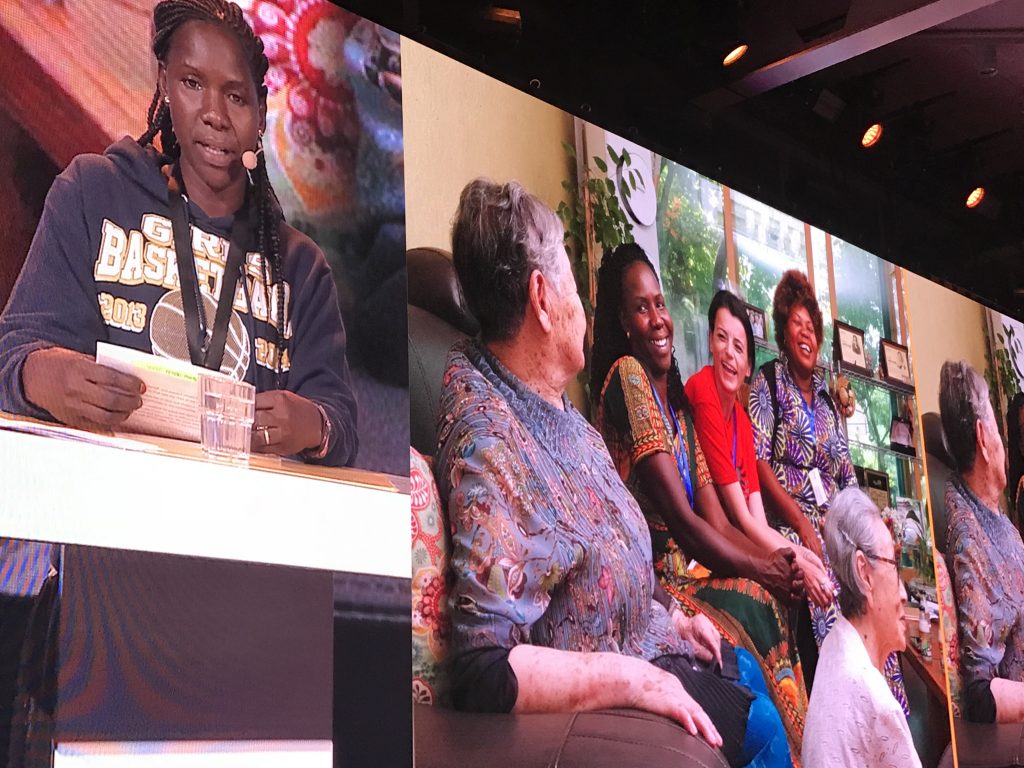 Again there was more complaints that this wasn’t what a plenary should be. But I think it was powerful. I can’t think if I’ve ever attended a speech or presentation in another language, where I had to be patient and wait for the translator to explain to me what was said. I’ve seen it on TV but I don’t think I’ve ever experienced it. We are used to being entertained, even at a conference. We expect to be entertained, we want experienced orators and a splash of humour. We want people that are comfortable on the stage and are talented storytellers. Some of our Plenary speakers were not and for me it was an important reminder of the outcome we are working towards, whether we work to end violence against women or to raise money for medical equipment and research or to stop climate change. Dalal and Sylvia represent the real people that our work is meant to support.
Again there was more complaints that this wasn’t what a plenary should be. But I think it was powerful. I can’t think if I’ve ever attended a speech or presentation in another language, where I had to be patient and wait for the translator to explain to me what was said. I’ve seen it on TV but I don’t think I’ve ever experienced it. We are used to being entertained, even at a conference. We expect to be entertained, we want experienced orators and a splash of humour. We want people that are comfortable on the stage and are talented storytellers. Some of our Plenary speakers were not and for me it was an important reminder of the outcome we are working towards, whether we work to end violence against women or to raise money for medical equipment and research or to stop climate change. Dalal and Sylvia represent the real people that our work is meant to support.
IFC Sessions I attended
Digital Fundraising
I made a very deliberate decision to not go to any digital fundraising sessions. I wanted to use the opportunity of a new environment and an international crowd to soak up some inspiration. But Steve Thomas, who invited me to speak at the Toronto Fundraising Congress last year, sought me out to suggest that I make the time to see Madeline Stanionis, a digital fundraiser from California. And I did, and it was worth it to hear what testing they had been doing and what was NOT working yet with donors for things like Chatbots and ‘Pledge to give later’ asks and what IS working, like ‘Facebook Fundraisers’ (via Facebook app which has NOT yet been released in Australia) and dollar handle nudges. I’m testing the nudge arrow graphic in Anglicare’s Christmas Appeal. I’ll let you know how it goes 🙂
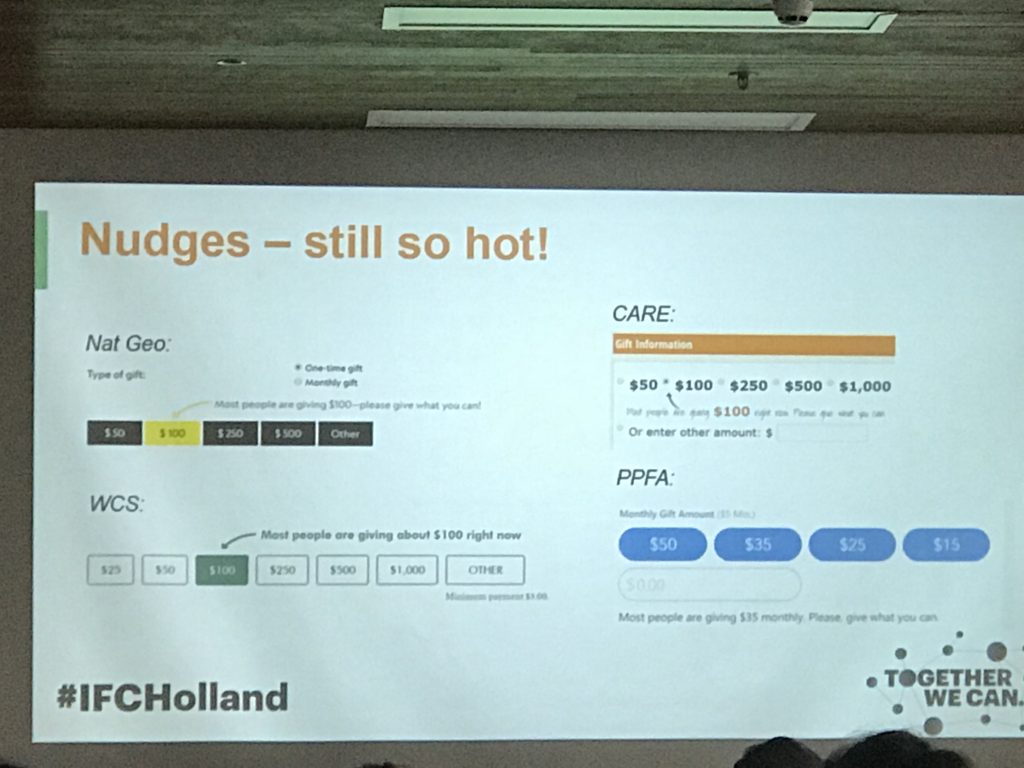
They seemed to do lots of research but most of the ones she mentioned were still in progress and she was non-committal on indicative results.
Telling Non-Profit Stories
I went to a few storytelling and Video content sessions – which didn’t really teach me much I didn’t already know but really made me accept that I need to push harder with our clients to develop video on a regular, cheap basis rather than always just trying to repurpose something that they already have. As its not our core business, we do it when the creative idea is led by video, like with a lot of the work we did with the Wilderness Society, but when stills tell the story adequately, I think I let budget concerns temper my enthusiasm for simple video.
Why you should make more videos? Video is how people prefer to consume content nowadays, on Facebook, without sound, using sub-titles. And in email, video screenshots get higher click through rates than emails with standard content.
But what I did learn from Michael Hoffman was the Hero’s Journey story arch. I’d never heard of Joseph Campbell and the pattern that he discovered in the best stories of all time – everything from the Odyssey to the Wizard of Oz can follow the Hero’s Journey storytelling framework. Since this was discovered in the 60’s – many writers have designed their stories around the Hero’s Journey, notably Star Wars and Harry Potter.
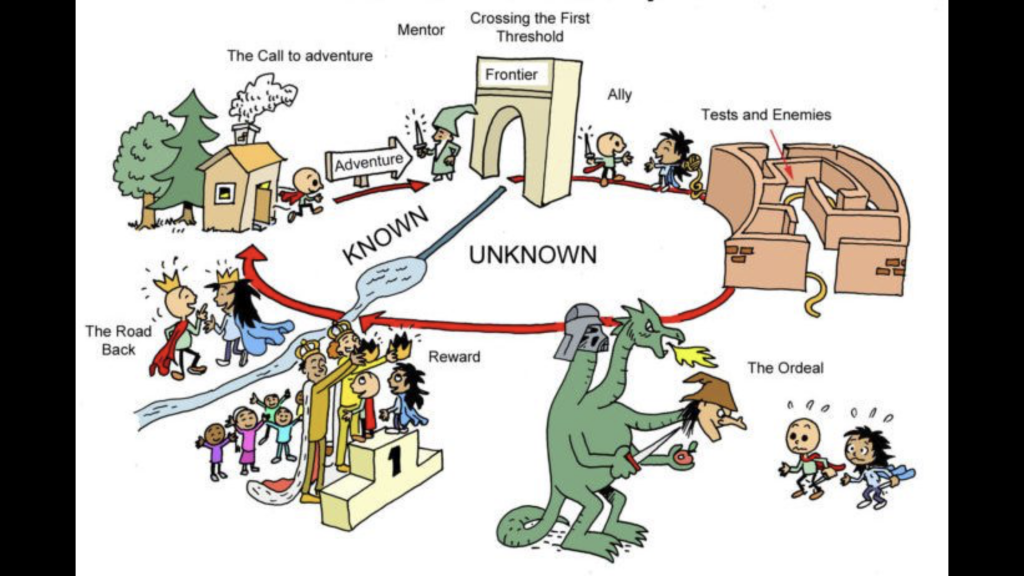
One of many illustrations of the Hero’s Journey Framework
Fundraising Strategy
I went to a ‘Strategy Map’ session where Angela Cluff showed me some good brain teasers for energisers in workshops I’m facilitating and as someone who often advocates a visual 1 page Digital Strategy, it was useful to take the 1 page strategy map and add the Scorecard and Implementation plan to it. My implementation plans tend to become long and onerous, so that was useful but I didn’t find the example of how it was implemented for MSF USA as insightful as I had hoped.
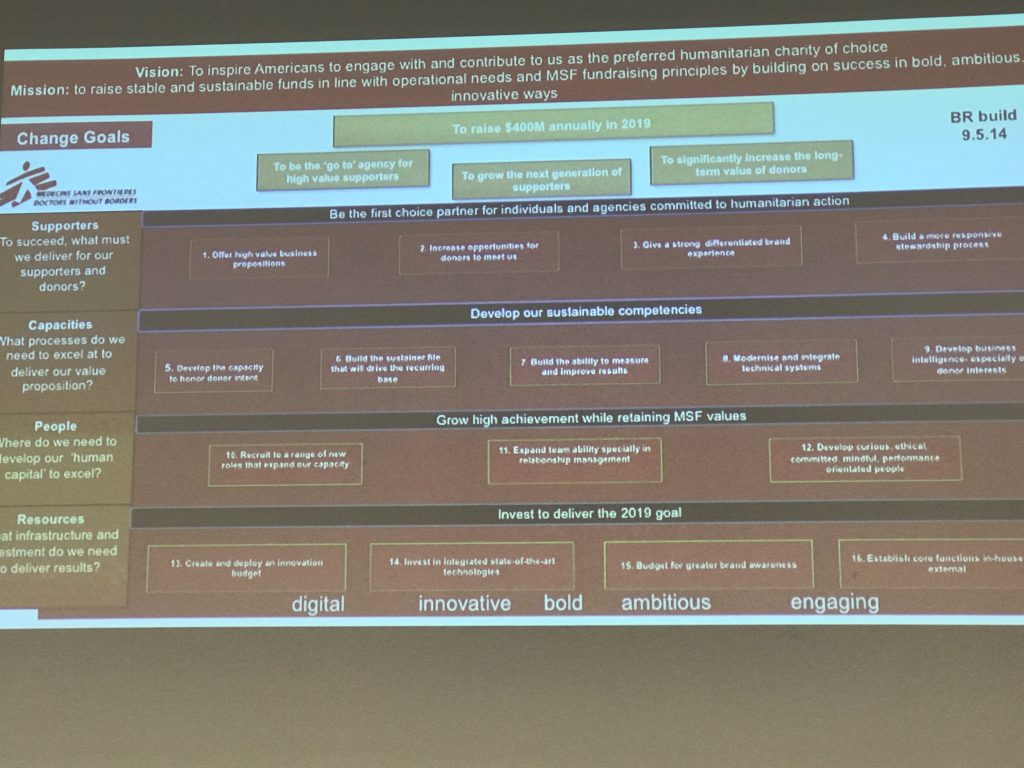
Human Centred Design
But the sessions that I loved was Katy Grennier’s workshop on Human Centred Design or Design Thinking and Bernard Ross (and Meredith Miles who is clearly super smart) teaching about ‘Decision Science’.
In the Human Centred Design workshop I had to go through the process of really listening to my partner’s challenge and following the Design Thinking methodology to design a prototype solution for how Unicef Globally can innovate their approach to bequest giving (which in the UK they call Legacy). I love the approach because its biased towards action (rather than just consultation, thinking and talking about action).
The 2 big take outs that I had from this were stupidly simple and greatly insightful for me.
1. Helping gets in the way of listening deeply.
Listening BUILDS TRUST. Not listening deeply will break any trust you had.
2. The human is at the centre, not the outcomes the organisation is trying to achieve.
We can’t design programs or solutions for beneficiaries if we start the planning process with organisational outcomes and objectives. Its for THEM, not for us.
For those whose interest is peaked, there are 5 stages/ phases of the [Stanford] Design Thinking process:
- Step Zero: who should be in the room to co-create? Comfortable enough to be creative and have conflict
- Empathy (really listening, be careful of biased questions)
- Define (the challenge you want to work on. You can’t know until you have listened to the personas)
-
- What does success look like for the users
-
- Ideation (blue sky, possibilities, play)
- Prototype/ Quick experiments (shortlist the ideas to try and develop)
-
- Liaise with the persona and get their feedback. Look for themes
-
- TEST the prototype with the intended audience.
And if you’re wondering what challenge I had my colleague at Unicef work on for me was… how to make the transition to being a Vegetarian. The prototype she gave me was to go 100% organic for 1 month and then host a Vegetarian dinner party/ BBQ with my friends to announce it and hold myself accountable.
Influencing Behaviour, Ethically
Bernard Ross’ session on Behavioural economics and the Predictable Irrationality of donors was definitely exciting and useful to me. But more than that, it provided data and case studies to support what I instinctively feel and implement, but perhaps not as consistently as I now can.
Behavioural economics are the practical rules and preconceived notions that we humans use to make decisions and its built on the fact that we really believe we are acting rationally, when in fact we’re mostly on autopilot and just react with our emotional brain because it uses less energy to make decisions that way. The irony is we “think” we are thinking about the decision rationally, when all we’ve done is make a decision based on what is known or familiar to us. Bernard summed it up nicely to say that “We are feeling machines that think”.
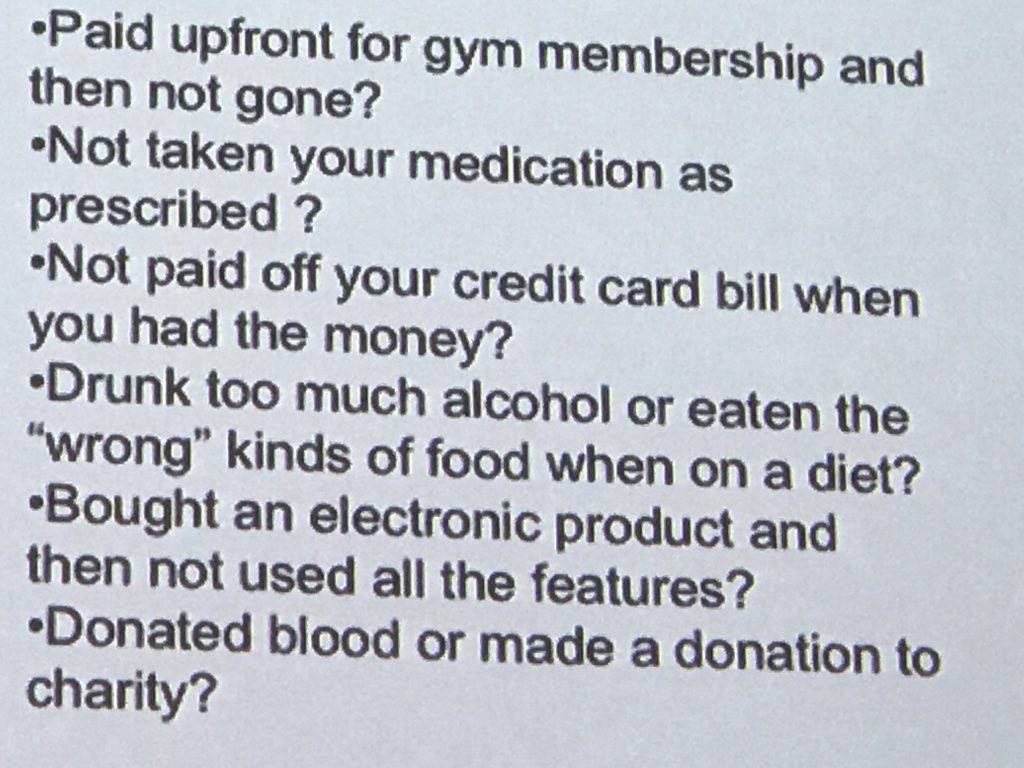
Examples of when people and donors are ‘predictably irrational’, given by Bernard Ross
As a fundraiser and marketer, it’s my job to make it easy for my donor to make a decision. We want to influence their behaviour by using social norms and sharing the actions of other people similar to them (or similar to how you want to see yourself or how you like others to see you).
Bernard had an Acronym to guide Fundraisers in their communication to donors – to help guide their decision making, in an ethical way. The EASIEST way to guide a donor is to follow this framework:
- Ethical
- Attractive (framing and anchoring )
- Social (norms)
- Info-lite (not too much info)
- Emotional
- Story-fied
- Time-based (people’s ability to remember things).
Having worked for the Ethics Centre and struggled to get the fine balance between ethics and morals, I asked this question and Bernard was able to articulate very well the Ethics of influences, which is how to influence behaviour without making the person start to think rationally. It is:
- Nudges are ethical if it’s a free choice
- in the best interest of the person (as judged by them)
- guiding towards a goal or outcome that is in their interests.
Honestly, Bernard Ross covered so much ground in this session and I can’t even begin to do it justice by summarising it here. Several people at the conference had mentioned Bernard Ross and raved about him a little, and he did not disappoint.
Bernard Ross’ new book is Change for Good – all profits are being donated to the Refugee Crisis, another great reason to buy it.
What else is good about IFC?
Diversity of the crowd – so many people from all over the world.
There are some pretty good ‘Wellness’ sessions – Meditation and Yoga and a Trust Circle.
The Gala Dinner was way more fun than I expected. I danced my substantial bootie off – bouncing between the Aussie Crew, the Blakely Canuck gals and helping Stephen George detach his skin from his mermaid pants.
The all-girl band “Too Hot To Handle” were brilliant and they knew their crowd, lots of 80’s and 90’s crowd pleasers.
The ‘Marketplace’ or the exhibition space was one of the best I’ve seen. Same type of businesses spruking their products and services but in a much more integrated way than most conferences and in a smaller space that was very inviting, less corporate.
For me, being able to hob-nob around with all the friends I made at the Toronto AFP Congress and build on those relationships was brilliant.
I mentioned the plenary’s already.
So yeah, it was great all round.
Should you go to the IFC in the Netherlands?
Absolutely, everyone should go if they can.
I was lucky, I happened to be based in Scotland for 3 months, so I could get across to Amsterdam and justify the trip, but from Australia, at 2000+ pounds for the ticket (about double what we would pay for a conference) plus the time out of the office and Europe travel costs – it’s largely prohibitive for many organisations and agencies, but I am so grateful that I finally got to go and now that I’ve been, I will absolutely try to go again!

